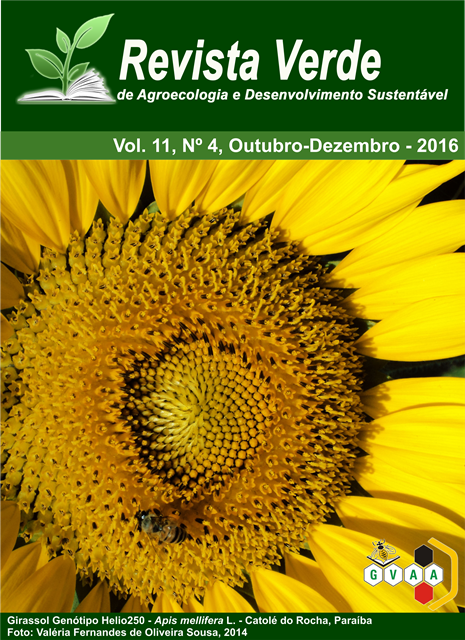Produtividade de tomate orgânico cultivado em diferentes ambientes e níveis de insumos
DOI:
https://doi.org/10.18378/rvads.v11i4.3964Keywords:
Lycopersicon esculentum, cultivo orgânico, cultivo protegido.Abstract
A importância alimentar do tomate orgânico aliado a sua baixa produção na Amazônia e a necessidade de baixo uso de insumos para seu cultivo ecológico o objetivo deste trabalho foi avaliar a produtividade de cultivares de tomate orgânico cultivado em campo e ambiente protegido com alto e baixo nível de insumos. Os experimentos foram conduzidos em ambiente protegido e campo, ambos no delineamento em blocos casualizados completos, em esquema de parcelas subdivididas 2 x 3, sendo a parcela principal composta por dois níveis de insumos e a subparcela pelas cultivares copa (Santa Kruz Kada, IPA 6 e Santa Clara), com cinco repetições de cinco plantas cada. As variáveis avaliadas foram: massa média de frutos total e comercial (g fruto-1), número de frutos total e comercial por planta, produtividade total e comercial de frutos (kg ha-1). A cultivar IPA 6 em cultivo protegido exigiu maior uso de insumos para aumentar a massa média de fruto total e comercial, produtividade total e comercial, em campo pode se utilizar baixo nível de insumo. O alto uso de insumos é necessário para aumentar a produtividade total e comercial para a cv. Santa Clara em cultivo à campo, ambiente que também necessita de alto uso de insumos para aumentar a massa média de fruto total e comercial a produtividade comercial da cultivar Santa Kruz.
Productivity of organic tomato grown in different environments and levels of inputs
Abstract: The importance of organic tomato feed associated with their low production in the Amazon and the need for low input to its ecological farming the objective of this study was to evaluate the productivity of organic tomato cultivars grown in field and greenhouse with high and low level inputs. The experiments were conducted under greenhouse and field conditions, both in randomized complete block design comprising plots subdivided into subplots. The plots encompassed of two levels of inputs, while the subplots contained the (Santa Kruz Kada, 6 and IPA Santa Clara), with five replicates of five plants each. The variables evaluated were: total fruit mass and marketable fruit mass (g fruit-1), number of total and marketable fruit per plant, total and marketable fruit yield (kg ha-1). The cultivar IPA 6 in greenhouse demanded greater use of inputs to increase the total and marketable fruit mass, total and marketable yield in field can be used for low level input. The high use of inputs is necessary to increase the total and marketable yield for cv. Santa Clara in the growing field, environment which also requires high use of inputs to increase the total and marketable fruit mass, marketable fruit yield of cultivar Santa Kruz.















